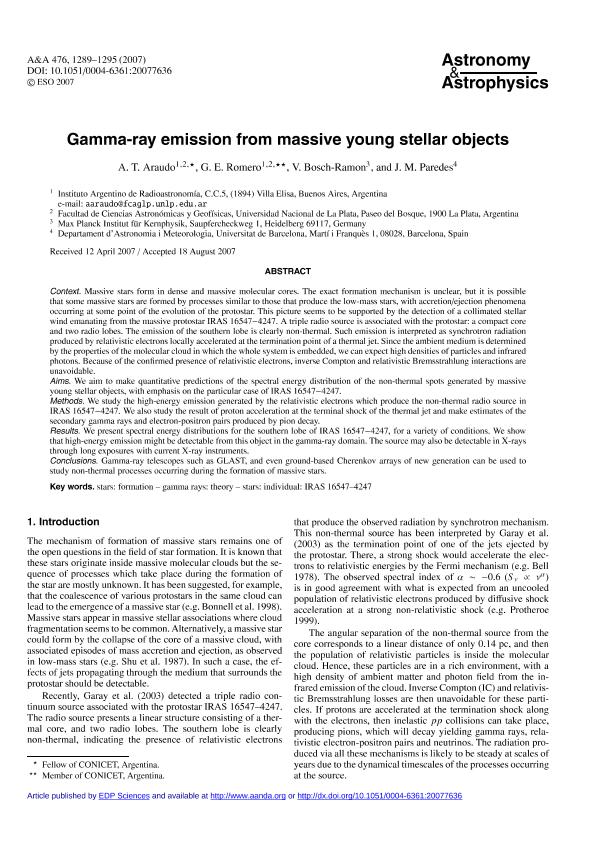Artículo
Gamma-ray emission from massive young stellar objects
Fecha de publicación:
12/2007
Editorial:
EDP Sciences
Revista:
Astronomy and Astrophysics
ISSN:
0004-6361
Idioma:
Inglés
Tipo de recurso:
Artículo publicado
Clasificación temática:
Resumen
Context. Massive stars form in dense and massive molecular cores. The exact formation mechanism is unclear, but it is possible that some massive stars are formed by processes similar to those that produce the low-mass stars, with accretion/ejection phenomena occurring at some point of the evolution of the protostar. This picture seems to be supported by the detection of a collimated stellar wind emanating from the massive protostar IRAS 16547−4247. A triple radio source is associated with the protostar: a compact core and two radio lobes. The emission of the southern lobe is clearly non-thermal. Such emission is interpreted as synchrotron radiation produced by relativistic electrons locally accelerated at the termination point of a thermal jet. Since the ambient medium is determined by the properties of the molecular cloud in which the whole system is embedded, we can expect high densities of particles and infrared photons. Because of the confirmed presence of relativistic electrons, inverse Compton and relativistic Bremsstrahlung interactions are unavoidable. Aims. We aim to make quantitative predictions of the spectral energy distribution of the non-thermal spots generated by massive young stellar objects, with emphasis on the particular case of IRAS 16547−4247. Methods. We study the high-energy emission generated by the relativistic electrons which produce the non-thermal radio source in IRAS 16547−4247. We also study the result of proton acceleration at the terminal shock of the thermal jet and make estimates of the secondary gamma rays and electron-positron pairs produced by pion decay. Results. We present spectral energy distributions for the southern lobe of IRAS 16547−4247, for a variety of conditions. We show that high-energy emission might be detectable from this object in the gamma-ray domain. The source may also be detectable in X-rays through long exposures with current X-ray instruments. Conclusions. Gamma-ray telescopes such as GLAST, and even ground-based Cherenkov arrays of new generation can be used to study non-thermal processes occurring during the formation of massive stars.
Palabras clave:
Formation of Stars
,
Gamma Rays
,
Iras 16547-4247 (Estrella)
,
Massive Stars
Archivos asociados
Licencia
Identificadores
Colecciones
Articulos(IAR)
Articulos de INST.ARG.DE RADIOASTRONOMIA (I)
Articulos de INST.ARG.DE RADIOASTRONOMIA (I)
Citación
Araudo, Anabella Teresa; Romero, Gustavo Esteban; Bosch Ramon, Valentí; Paredes, Josep Maria; Gamma-ray emission from massive young stellar objects; EDP Sciences; Astronomy and Astrophysics; 476; 12-2007; 1289-1295
Compartir
Altmétricas




